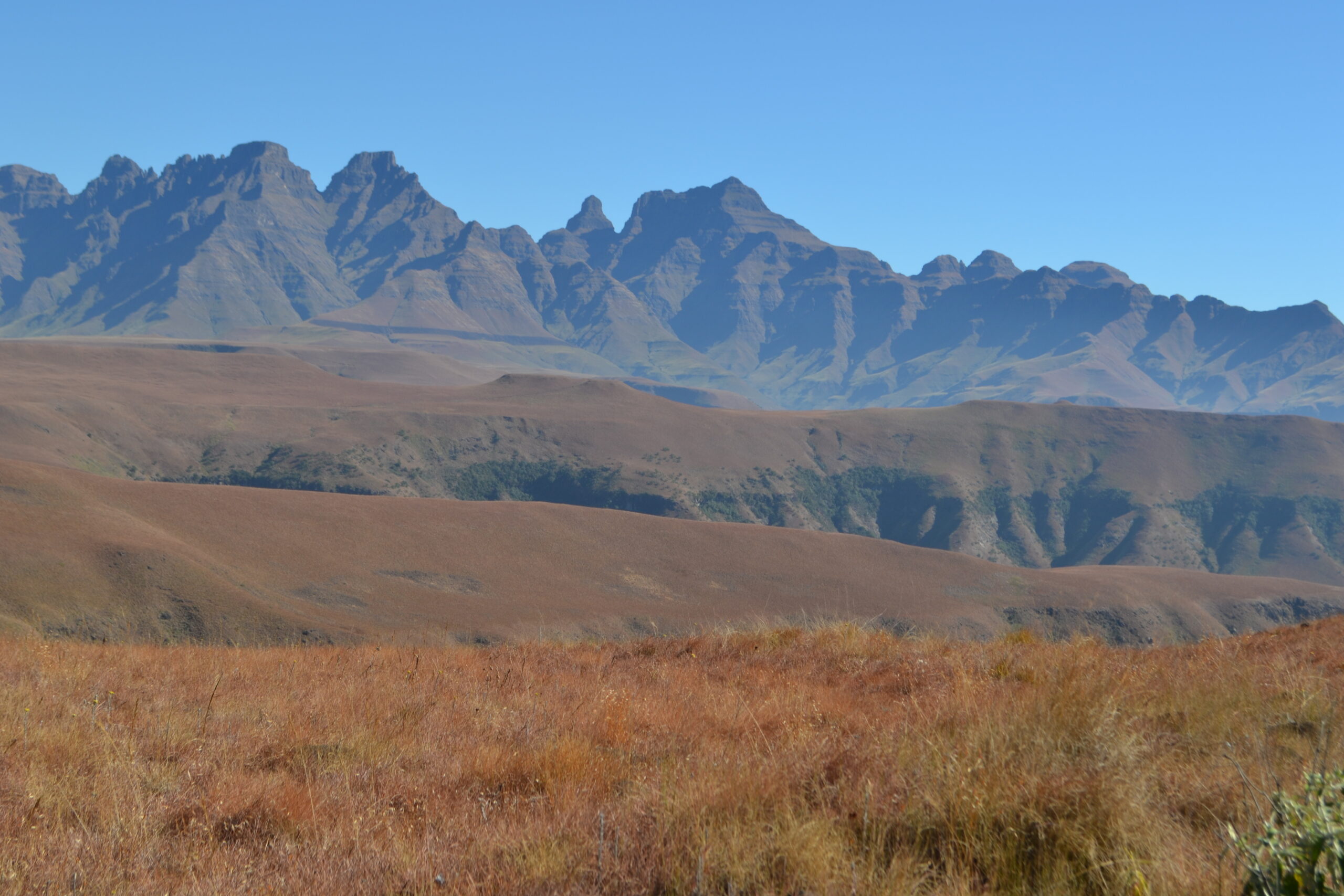
17 Jul The Drakens in the Berg
Billowing grasslands across volcanic mountains towering at 3000+ meters and no humans in sight, we only came across a broken off sole of a Basotho gum boot in our two days in the Berg. These are the Dragon’s Mountains or Drakensberg.
It was vigorously bumpy ride up the road to Cambalala Hut in the Northern Berg near Cathedral Peak. Gunther, my climbing partner Marco’s Subaru, was holding up well even at a 350,000 kilometer milestone. Marco is an Italian who did his PhD in Switzerland and somehow ended up in Pietermaritzberg a couple years back. We were welcomed by MCSA (Mountain Club of South Africa) members who were helping renovate the hut.
Before we started heading up, one man was giving us advice for the hike. He warned us about the Basotho people who were recently throwing stones at hikers. Marco replied that he shouldn’t be making those generalizations and that most Basothos are peaceful.
There have been infrequent incidents in the past with shepherds from the Basotho tribe crossing paths with hikers and robbing them. Marco gave me some pepper spray to carry and said that some people have started to carry guns in the Berg, but he believed that more guns would not help.
He mentioned that a friend of his had an interesting encounter with some Basothos. They were walking along in a group of two men and two women when they were approached by one man with uniform pants and a civilian shirt on and another man with a uniform shirt and civilian pants. They claimed to be border patrol and both carried AK-47’s.
One was clearly under the influence and began to escalate the situation. Luckily, Marco’s friend did not take out his gun because if he did, someone would have gotten hurt. The other “border patrol” guy stepped in to talk some sense into his friend and the situation dissipated, the outcome being a punishment of 40 pushups for the hikers.
“I’d hate to say it, but if it were just the two women without two large men, the outcome might have been different,” Marco said. “Those guys were on a power trip and knew there would be no consequences.”
In these mountains, there is no accountability or law. It’s truly like what the Wild West used to be with cowboys and lawlessness. It’s not that this specific group of people is inherently worse than other groups, but in these circumstances where there is no one around, poverty is common and anything is fair game, it’s more likely for criminal behavior to occur.
When it comes to safety for traveling females, I’m always reminded that women are attacked not because they are weaker, but because they are perceived as targets. Women do not need extra precautions because of something inherent about women that makes them more susceptible to dangers, but because of the societal power constructs that make people think pointing a gun at a woman is easier than pointing one at a man.
When I went for my morning poop, Marco said to bring pepper spray just in case because the cave at 3100-some meters is near where the shepherds pass by. The only interactions he had with Basothos were friendly, but it’s better to be more cautious.
“Why would they rob hikers?” I asked. “We don’t have anything with us.”
He said that you may think you don’t have anything, but if you look at how the Basothos live, what they have is much more minimal. The worst that usually happens in the Berg is getting your hiking gear and boots stolen. In comparing my boots to theirs, I could see why they would be tempted to steal. The bottom of that fallen off gum boot sole was worn and patched. The Basothos culture is very unwasteful; they will keep repairing old boots to last as long as possible.

On the other side of these mountains is a poorer country: Lesotho—tiny, mountainous and landlocked by Africa’s economic powerhouse, South Africa. Hikers/climbers, Basothos and there’s one other group of people who walk the mountain paths—dagga (marijuana) smugglers who strap sacks onto mules, crossing from Lesotho into South Africa through the desolate plains of the Berg. Apparently, they try to maintain a low profile and don’t bother the hikers in the area.
It was a 7 hour hike up on day one and a 6 hour hike down on day two. The man at the hut said that it was 3.5-5 hours to get to Roland’s Cave. I would love to know who made it in 3.5 hours without having to run. Marco said that it’s the norm to give unreliably short hiking times for the Berg. Granted, we had 45-55 liter packs on us and got a bit lost on the way up and had to follow the burn path up and down another large hill to cut across to the correct path, but even then, it would only shave an hour off our time.
We spent the night sleeping in the spacious, sheltered and cold Roland’s Cave. Throughout the entire hike, the only sounds we heard were the roaring wind, distant baboons, some hawks and, well, each other.

There’s really nothing here except sweeping views and anarchy.
The hiking map of the Berg is largely misleading, the caves are not marked correctly, there’s lots of misleading paths, the coordinates aren’t always right, no real path is the norm—it all reminds me of my two months in Alaska last summer. The last hour or two is a steep climb up an unpleasant gully and then a wander to find the small opening across the exposed traverse to the cave. My legs really were not agreeing with me going up the gully and it was getting harder to breathe as we climbed above 3000 meter altitude.
I really underestimated the size of this mountain, largely because there’s no snow on it. Anywhere else in the world at this altitude, there’d be snow and at many times glaciers. From the base, the Drakensberg just looks like a collection of very large, green hills. It sounds dumb, but on that gully, it hit me that these are real mountains. I mean, no one outside of Africa thinks of huge mountains when they think about South Africa, and I carried that bias into my hiking and climbing.
Last summer in Alaska, I did a really hard 10-hour hike—a loop around Fireweed Mountain (2500 m altitude and surrounded by glaciers)—with my host family in McCarthy. The way down was the most miserable I had ever been on a hike because we were just getting lost crashing through trees and bush. It felt so endless, exactly what I was feeling like on the way to Roland’s Cave. Not that I didn’t have the time of my life on both hikes though, of course.
Marco kept saying that we were almost there and at some point, the GPS said that we were only a few hundred meters (direct distance) from the cave. It took another hour of trudging uphill and meandering for that last bit. I had been climbing and figure skating a lot without any rest days, so my calves were screaming. As I was lugging me and my pack up the steep gully in the gusting cold wind after already hiking uphill for six hours, I really started to understand why normal people just stay in and watch Netflix instead of slogging up a cliff.
I was considering maybe starting a more domestic chapter of my life. I started muttering to Marco: I hate caves, wind, stars, spiky grass, grass in general, sunsets, everything. But, the suffering followed by the otherworldly views always makes leaving a warm house for a cold cave worthwhile. My brain quick to forget pains and struggles, so I always end up doing it again.

The guy at the hut also told us that we could refill our water in the stream before the gully, and in this dry winter season, the stream was a sad trickle. In the morning after the cave, the stream was largely frozen with some dangling icicles. As Marco was making a sad attempt to fill up his water bottle, I peeled my orange and lost my grip on it. I watched with horror as it tumbled down the mountainside out of sight.
With how utterly dry it looks in the winter, it’s crazy to think that the Maloti-Drakensberg range makes up the principal water production area of South Africa.




Sorry, the comment form is closed at this time.